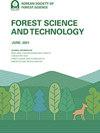Population genetic of the Indonesian rosewood (Dalbergia latifolia) from Java and West Nusa Tenggara revealed using sequence-related amplified polymorphism
IF 2.2
Q2 FORESTRY
引用次数: 0
Abstract
Abstract Dalbergia latifolia is commercial tropical tree species known for its beautiful heartwood, mainly used for furniture and musical instrument. High market demand has put concerns on its sustainability and conservation aspects in Indonesia. Ninety-five specimens of D. latifolia were collected from eight populations of Java, Lombok, and Sumbawa Island to study intraspecific variability and diversity using SRAP. One hundred and eighty SRAP loci with 54.03% ± 4.35% polymorphism obtained from PCR amplification of 10 primer combinations, with the average PIC for these primers of 0.28. Genetic diversity and variability measures were calculated using GenAlEx software indicating a relatively low-mid level of percentage of polymorphic loci (PPL) (54.03%), effective number of alleles (Ne) (1.255), Shannon information index (I) (0.242), and heterozygosity (He) (0.156) on average. The highest value (I = 0.309, He = 0.196) was observed in population P2CJ (Central Java), followed by West Java of P1WJ (I = 0.300, He = 0.191) and West Sumbawa of P7Wsumb (I = 0.257, He = 0.169), while the lowest (I = 0.202, He = 0.129) was found in West Lombok (P4WL). The genetic relationships were measured from genetic distance and identity from the two-pairwise calculation, PCoA, and STRUCTURE analysis. The relative homologous population is found between populations Central and West Java of P2CJ and P1WJ (Nei uD = 0.031), suggesting these populations have the same origin and formed one population, while the most distinct (Nei uD = 0.157) was recorded between Sumbawa regency (P6Sumb) and East Java (P3EJ). The results from PCoA showed that all individuals are placed in three groups almost in accordance with their respective islands, i.e. a group comprised inclusively trees from Sumbawa island, a group of Lombok and some Central Java trees, and a group of trees from Java with the exclusion of some trees of Central Java that were clustered with trees from Lombok island. This result was also supported by STRUCTURE analysis, which showed that Sumbawa, Lombok, and West-East Java populations formed their respective clusters, and Central Java population contains a mixture of West-East Java and Lombok populations. This may suggest evidence of complex origin, thus needing further study to clarify. It is recommended that the populations with the highest value of genetic diversity (Central and East Java) are to be maintained as the source of the gene pool for genetic enrichment programs.利用序列相关扩增多态性分析了爪哇和西努沙登加拉地区印尼红木(Dalbergia latifolia)的群体遗传
黄檀(Dalbergia latifolia)是一种热带商业树种,以其美丽的心材而闻名,主要用于家具和乐器。在印度尼西亚,高市场需求引起了人们对其可持续性和保护方面的关注。在爪哇岛、龙目岛和松巴哇岛的8个居群中采集了95份大叶瓢虫标本,利用SRAP分析了其种内变异性和多样性。10个引物组合PCR扩增得到180个SRAP位点,多态性为54.03%±4.35%,平均PIC为0.28。采用GenAlEx软件计算遗传多样性和变异率,结果表明,平均多态性位点百分率(PPL)为54.03%,有效等位基因数(Ne)为1.255,Shannon信息指数(I)为0.242,杂合度(He)为0.156。中爪哇P2CJ种群最高(I = 0.309, He = 0.196),其次是P1WJ的西爪哇(I = 0.300, He = 0.191)和P7Wsumb的西松巴哇(I = 0.257, He = 0.169),西龙目岛(P4WL)最低(I = 0.202, He = 0.129)。通过二对计算、PCoA和结构分析的遗传距离和同源性来测定遗传关系。P2CJ和P1WJ在爪哇中部和西部种群间存在相对同源群体(Nei uD = 0.031),表明这两个种群起源相同,形成了一个种群,而松巴哇县(P6Sumb)和东爪哇(P3EJ)之间差异最大(Nei uD = 0.157)。PCoA结果表明,所有个体几乎按照各自的岛屿分为三组,即一组包括来自松巴哇岛的树木,一组包括龙目岛和一些中爪哇树木,另一组来自爪哇,但不包括与龙目岛树木聚集在一起的中爪哇树木。这一结果也得到了结构分析的支持,松巴哇、龙目岛和西-东爪哇种群形成了各自的集群,而中爪哇种群包含西-东爪哇和龙目岛的混合种群。这可能暗示了复杂起源的证据,因此需要进一步的研究来澄清。建议保留遗传多样性最高的居群(中爪哇和东爪哇)作为遗传富集项目的基因库来源。
本文章由计算机程序翻译,如有差异,请以英文原文为准。
求助全文
约1分钟内获得全文
求助全文

 求助内容:
求助内容: 应助结果提醒方式:
应助结果提醒方式:


